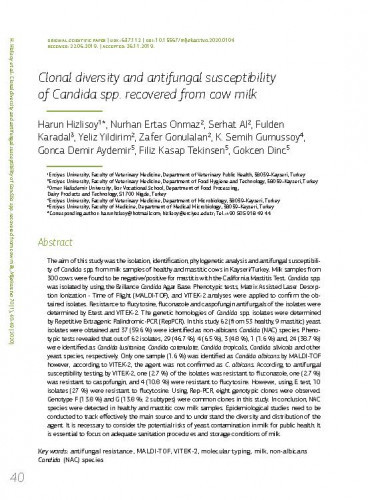The aim of this study was the isolation, identification, phylogenetic analysis and antifungal susceptibility of Candida spp. from milk samples of healthy and mastitic cows in Kayseri/Turkey. Milk samples from 300 cows were found to be negative/positive for mastitis with the California Mastitis Test. Candida spp. was isolated by using the Brillance Candida Agar Base. Phenotypic tests, Matrix Assisted Laser Desorption Ionization - Time of Flight (MALDI-TOF), and VITEK-2 analyses were applied to confirm the obtained isolates. Resistance to flucytosine, fluconazole and caspofungin antifungals of the isolates were determined by Etest and VITEK-2. The genetic homologies of Candida spp. isolates were determined by Repetitive Extragenic Palindromic-PCR (RepPCR). In this study 62 (from 53 healthy, 9 mastitic) yeast isolates were obtained and 37 (59.6 %) were identified as non-albicans Candida (NAC) species. Phenotypic tests revealed that out of 62 isolates, 29 (46.7 %), 4 (6.5 %), 3 (4.8 %), 1 (1.6 %) and, 24 (38.7 %) were identified as Candida lusitaniae, Candida catenulate, Candida tropicalis, Candida silvicola and other yeast species, respectively. Only one sample (1.6 %) was identified as Candida albicans by MALDI-TOF however, according to VITEK-2, the agent was not confirmed as C. albicans. According to antifungal susceptibility testing by VITEK-2, one (2.7 %) of the isolates was resistant to fluconazole, one (2.7 %) was resistant to caspofungin, and 4 (10.8 %) were resistant to flucytosine. However, using E test, 10 isolates (27 %) were resistant to flucytosine. Using Rep-PCR, eight genotypic clones were observed. Genotype F (13.8 %) and G (13.8 %; 2 subtypes) were common clones in this study. In conclusion, NAC species were detected in healthy and mastitic cow milk samples. Epidemiological studies need to be conducted to track effectively the main source and to understand the diversity and distribution of the agent. It is necessary to consider the potential ris; Cilj ovog istraživanja bila je izolacija, identifikacija, filogenetska analiza i analiza antifungalne podložnosti vrste Candida spp. iz uzoraka mlijeka zdravih i mastitičnih krava muzara s područja Kayseri u Turskoj. Uzorci mlijeka izuzeti od 300 krava analizirani su pomoću California Mastitis Test-a na prisutnost mastitisa. Candida spp. izolirana je pomoću selektivne podloge Brillance Candida Agar Base. Za potvrđivanje dobivenih izolata korišteni su fenotipski testovi, MALDI-TOF masena spektrometrija i VITEK-2 analize. Rezistencija izolata na fungicide fluktozin, flukonazol i kaspofungin testirana je primjenom Etesta i VITEK-2. Genetski homolozi izolata vrste Candida spp. određeni su primjenom RepPCR metode. U ovom istraživanju ispitivana su 62 izolata (53 od zdravih, 9 od mastitičnih krava) kvasca, a 37 (59,6 %) ih je identificirano da ne pripadaju vrsti Candida albicans (NAC). Fenotipski testovi pokazali su da od 62 izolata, njih 29 (46,7 %), 4 (6,5 %), 3 (4,8 %), 1 (1,6 %) i 24 (38,7 %) identificirani su kao sojevi Candida lusitaniae, Candida catenulate, Candida tropicalis, Candida silvicola te neke druge vrste kvasaca. Samo je jedan uzorak (1,6 %) identificiran kao Candida albicans pomoću metode MALDI-TOF, no nije potvrđen i metodom VITEK-2. Prema testiranju antifungalne osjetljivosti metodom VITEK-2, jedan (2,7 %) od izolata je bio rezistentan na flukonazol, jedan (2,7 %) na kaspofungin, i 4 (10,8 %) bili su rezistentni na flucitozin. Međutim, primjenom E testa, 10 izolata (27 %) bilo je rezistentno na flucitozin. Primjenom Rep-PCR metode utvrđeno je osam genotipskih klonova. Najčešći klonovi određeni u ovom istraživanju bili su genotipi F (13,8 %) i G (13,8 %; 2 podtipa). Zaključno, prisutnost NAC vrsta utvrđena je u uzorcima mlijeka i zdravih i mastitičnih krava. Potrebno je provesti epidemiološke studije kako bi se efikasno utvrdio glavni izvor istih te kako bi se razumjela raznolikost i distribucija klonova.
Sažetak

 Mljekarstvo.com : časopis za unaprjeđenje proizvodnje i prerade mlijeka : 70,1(2020) / glavna i odgovorna urednica, editor in chief Rajka Božanić.
Mljekarstvo.com : časopis za unaprjeđenje proizvodnje i prerade mlijeka : 70,1(2020) / glavna i odgovorna urednica, editor in chief Rajka Božanić.